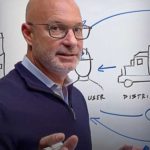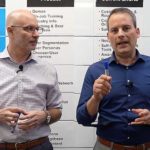What Manufacturers Can Learn from Fastenal’s Go-To-Market Strategy
This article was reprinted with permission from Modern Distribution Management (MDM) from their MDM Premium Content. It is a great publication and we highly recommend becoming an MDM Premium subscriber, for over 50 years MDM has provided industry leading content for B2B Manufacturers and Distributors. Become an MDM Premium subscriber at https://www.mdm.com/subscribe_premium/
Fastenal’s 2022 first quarter financial report shows the evolving need for manufacturers to adjust their sales plans and tactics for distributors. About 10 years ago, the B2B distribution business was simple: The more calls your outside account managers could make on customers, the more those customers would buy. You built your sales process on this foundation of face-to-face interactions. Pre-smartphone your team was a key driver of customer training and you marketed to the end customers using events, counter days, and hands-on lunch-and-learn training. Relationship selling dominated and manufacturers tried to grow share by fighting for shelf space and mindshare with the distributor vs. the end customer.
You won together by having the best team, with the right inventory in branches near the customer, to ensure delivery excellence. Then the digital world changed and slowly so did B2B Distribution. COVID induced remote selling and customer contact just accelerated the changes that had been happening in B2B, where customers increasingly want self-service and e-commerce solutions vs. face-to-face selling.
Fastenal’s latest quarterly report shows they are continuing to adjust their customer coverage plans to meet these ever-growing customer “self-service” expectations.
Fastenal is one of the most successful North American distribution stories. They were a branch-based B2B distributor, one of the key drivers of Fastenal’s growth strategy was to open branches in cities and small towns and put inventory and support close to the customer. In many markets, they might have been the only B2B industrial or construction distributor in the city and they had probably the world’s largest fleet of white pickup trucks just zipping around to deliver products everywhere.
It was a winning strategy and by 2013, Fastenal branches had expanded to a company peak of 2,687 locations. Branch locations, personal account manager support were still the key relationship drivers in 2013, it was a winning strategy for their business.
Then, we all got smartphones and the digital revolution started changing what B2B distribution customers view as the key drivers of their relationship.
Today, B2B end customers continue to rapidly move from human interactions to digital interactions. The self-service influence of e-commerce, websites and digital interactions has skyrocketed. The human-to-human influence of branches and the account manager is declining, and what customers value about what B2B distributors do is changing.
Key Fastenal adjustments since 2013 – with COVID acceleration
With branch influence on the customer relationship declining, Fastenal is adjusting and has made some major pivots in their strategy. The company now has 1,740 branches in Q1 2022 — a decline of almost 1,000 locations in the past 8 years.
E-commerce, website and digital solutions are gaining traction for B2B end customers. In response, Fastenal has adjusted and doubled down on its onsite vending machines, and e-commerce capabilities.
Fastenal has continued to invest in customer self-serve vending solutions and reporting. Installed devices accounted for 94,425 in Q1 2022 — an increase of 12.1% from prior year Q1 2021. The investment in plant-floor self-service vending solutions that create digital POs and replenishment orders is a key differentiator for Fastenal.
These appear to be sound business adjustments from one of the largest B2B distributors to adjust to the new distribution reality. Fastenal was in 2013, at its core, a branch-based distributor, but they have radically adjusted their sales model to deal with their changing end customer demands.
A decade ago, if you read that a distributor closed ~1,000 branch locations in eight years, most would think it was related to bankruptcy proceedings. Fastenal’s sales have almost doubled from $3.3 billion in 2013 to over $6 billion in 2021 with no significant acquisitions. I would say that is the opposite of a problem.
Fastenal is also investing heavily in digital solutions and point-and-click e-commerce. Fastenal reports that sales through their Digital Footprint (FMI technology plus non-FMI-related eCommerce) was an amazing 47.0% of sales in 1Q 2022.
The growth of end customer digital and self-service buying preferences are triggering a major shift in not just Fastenal’s strategy, as these same trends are changing how manufacturers go to market.
What can manufacturers learn from Fastenal?
It’s time to consider adjusting your direct sales coverage plan for B2B distribution branches. Do you need the same number of route-running direct sales professionals that go from branch to branch doing lunch-and-learns and relationship-building programs? The self-service end customer has changed the game. B2B manufacturers must rebalance their field sales, inside sales, manufacturing reps, digital sales and channel marketing teams to be successful in the distribution channel.
You can drive demand and preference for your brand at the end user. In our most recent Dorn Manufacturer’s Survey we found that 56% of manufacturers are seeking to add a direct sales channel to work in conjunction with their existing distribution channel.
This is not about replacing distribution and selling direct, it’s just a realization that in the digital world the end customer expects to be able to communicate directly with the manufacturer.
Who better to communicate the brand message and value proposition to the buying end customer than the supplier who owns the brand? This is creating demand that will benefit the distributor, but it also gives you the ability to partner deeper together on sales opportunities.
Adjust for your business and understand your channel. The reality of end customer self-service is that some B2B distributors will be positioned to be better long-term partners for your brand than others. For example, a traditional outside sales-driven distributor that relies solely on legacy relationship selling is probably not going to help you grow long term as well as a modern distributor that has direct-selling inside sales, strategic field sales, managed inventory, and strong e-commerce capabilities.
Those digital-driven distributors with strong value-added services and a modern sales strategy (strategic outside, inside outbound and inbound, e-commerce and digital) are going to outperform the legacy relationship sellers in the future.
Customer Journey Mapping is a critical breakthrough for many manufacturers. It’s often an overused term “customer journey”, but can you map that end customer interaction from your brand website to the end customer effectively? How does your distributor or manufacturer rep add value or participate in those interactions? If you understand that end-to-end customer journey you can create demand and drive it through your channel — in the manner you want. This yields customer loyalty and brand preference that you can use to build your brand and business.
Use your Market Development Funds (MDF) and Co-Op to grow business. The reality is funding golf outings, lunch-and-learns, and counter days will not get the return on investment that they did a few years ago. Many manufacturers are still using almost all their MDF funds for shelf space conversion programs (Mr. Distributor, please take this money to switch from this brand to my brand). It’s time to divert at least some of those funds to direct end customer interaction and drive preference for your brand. The one universal truth in B2B distribution is if the end customer demands your brand, they will find the distributor or channel to get it.
End customer self-service is here to stay, and we are not going back to 2013. Manufacturers that embrace the self-service digital future are going to win more often and take share from those who have sales strategies that just require a flip-phone.
About James Dorn
James Dorn is the President and CEO of the Dorn Group. He is a proven leader with more than 25 years of consulting experience helping growth-minded executives across manufacturing and distribution firms build modern revenue growth strategies. James is a true innovator and results-oriented executive that draws upon a mix of market-back principles, competitive intelligence, agile strategic planning and data-driven decisions to help commercial teams more effectively acquire, grow and retain customers. He emphasizes the power of alignment across the product, marketing, sales and service teams for helping industrial firms build more efficient and effective business models that win market share.





